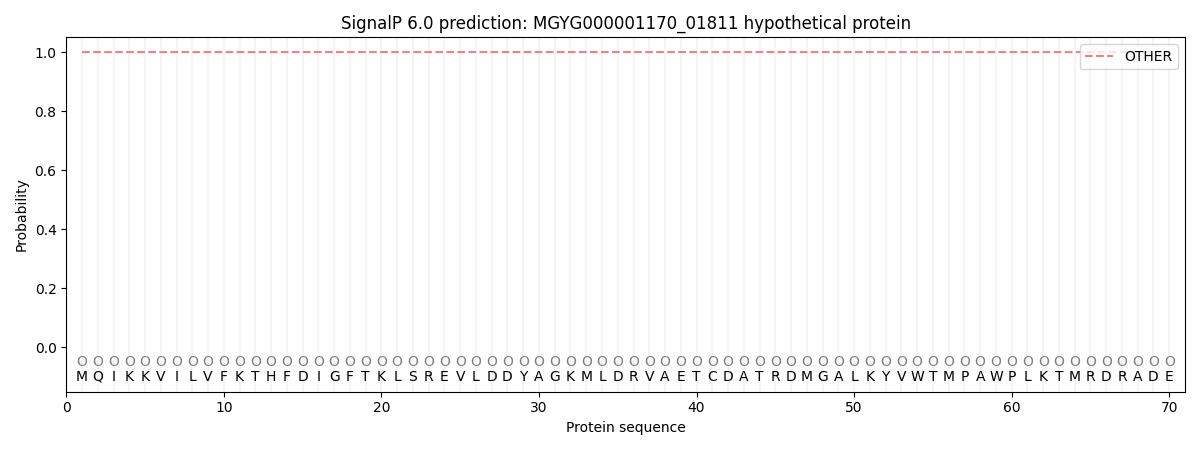You are browsing environment: HUMAN GUT
CAZyme Information: MGYG000001170_01811
You are here: Home > Sequence: MGYG000001170_01811
Basic Information |
Genomic context |
Full Sequence |
Enzyme annotations |
CAZy signature domains |
CDD domains |
CAZyme hits |
PDB hits |
Swiss-Prot hits |
SignalP and Lipop annotations |
TMHMM annotations
Basic Information help
| Species | UMGS1603 sp900759005 | |||||||||||
|---|---|---|---|---|---|---|---|---|---|---|---|---|
| Lineage | Bacteria; Firmicutes_A; Clostridia_A; Christensenellales; CAG-74; UMGS1603; UMGS1603 sp900759005 | |||||||||||
| CAZyme ID | MGYG000001170_01811 | |||||||||||
| CAZy Family | GH0 | |||||||||||
| CAZyme Description | hypothetical protein | |||||||||||
| CAZyme Property |
|
|||||||||||
| Genome Property |
|
|||||||||||
| Gene Location | Start: 3657; End: 5942 Strand: - | |||||||||||
CDD Domains download full data without filtering help
| Cdd ID | Domain | E-Value | qStart | qEnd | sStart | sEnd | Domain Description |
|---|---|---|---|---|---|---|---|
| cd10791 | GH38N_AMII_like_1 | 3.76e-51 | 5 | 267 | 1 | 254 | N-terminal catalytic domain of mainly uncharacterized eukaryotic proteins similar to alpha-mannosidases; glycoside hydrolase family 38 (GH38). The subfamily of mainly uncharacterized eukaryotic proteins shows sequence homology with class II alpha-mannosidases (AlphaAMIIs). AlphaAMIIs possess a-1,3, a-1,6, and a-1,2 hydrolytic activity, and catalyze the degradation of N-linked oligosaccharides. The N-terminal catalytic domain of alphaMII adopts a structure consisting of parallel 7-stranded beta/alpha barrel. This subfamily belongs to the GH38 family of retaining glycosyl hydrolases, which employ a two-step mechanism involving the formation of a covalent glycosyl enzyme complex; two carboxylic acids positioned within the active site act in concert: one as a catalytic nucleophile and the other as a general acid/base catalyst. |
| pfam16477 | DUF5054 | 2.04e-11 | 279 | 469 | 8 | 226 | Domain of unknown function (DUF5054). This family consists of Glycosyl hydrolase family 38 proteins around 700 residues in length and is mainly found in various Clostridium and Rhizobium species. The function of this family is unknown. |
| cd10814 | GH38N_AMII_SpGH38_like | 4.84e-05 | 167 | 263 | 157 | 269 | N-terminal catalytic domain of SPGH38, a putative alpha-mannosidase of Streptococcus pyogenes, and its prokaryotic homologs; glycoside hydrolase family 38 (GH38). The subfamily is represented by SpGH38 of Streptococcus pyogenes, which has been assigned as a putative alpha-mannosidase, and is encoded by ORF spy1604. SpGH38 appears to exist as an elongated dimer and display alpha-1,3 mannosidase activity. It is active on disaccharides and some aryl glycosides. SpGH38 can also effectively deglycosylate human N-glycans in vitro. A divalent metal ion, such as a zinc ion, is required for its activity. SpGH38 is inhibited by swainsonine. The absence of any secretion signal peptide suggests that SpGH38 may be intracellular. |
| cd04171 | SelB | 0.006 | 113 | 163 | 38 | 92 | SelB, the dedicated elongation factor for delivery of selenocysteinyl-tRNA to the ribosome. SelB is an elongation factor needed for the co-translational incorporation of selenocysteine. Selenocysteine is coded by a UGA stop codon in combination with a specific downstream mRNA hairpin. In bacteria, the C-terminal part of SelB recognizes this hairpin, while the N-terminal part binds GTP and tRNA in analogy with elongation factor Tu (EF-Tu). It specifically recognizes the selenocysteine charged tRNAsec, which has a UCA anticodon, in an EF-Tu like manner. This allows insertion of selenocysteine at in-frame UGA stop codons. In E. coli SelB binds GTP, selenocysteyl-tRNAsec, and a stem-loop structure immediately downstream of the UGA codon (the SECIS sequence). The absence of active SelB prevents the participation of selenocysteyl-tRNAsec in translation. Archaeal and animal mechanisms of selenocysteine incorporation are more complex. Although the SECIS elements have different secondary structures and conserved elements between archaea and eukaryotes, they do share a common feature. Unlike in E. coli, these SECIS elements are located in the 3' UTRs. This group contains bacterial SelBs, as well as, one from archaea. |
CAZyme Hits help
| Hit ID | E-Value | Query Start | Query End | Hit Start | Hit End |
|---|---|---|---|---|---|
| AUS95533.1 | 5.86e-135 | 8 | 654 | 9 | 740 |
| AIA19246.1 | 1.14e-124 | 3 | 653 | 5 | 715 |
| AQT68768.1 | 6.57e-93 | 3 | 757 | 243 | 1100 |
| AOW10779.1 | 7.72e-85 | 2 | 723 | 41 | 853 |
| SDS35267.1 | 9.66e-82 | 8 | 645 | 39 | 757 |
Swiss-Prot Hits help
SignalP and Lipop Annotations help
This protein is predicted as OTHER

| Other | SP_Sec_SPI | LIPO_Sec_SPII | TAT_Tat_SPI | TATLIP_Sec_SPII | PILIN_Sec_SPIII |
|---|---|---|---|---|---|
| 1.000053 | 0.000000 | 0.000000 | 0.000000 | 0.000000 | 0.000000 |
